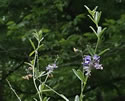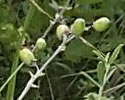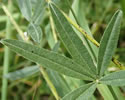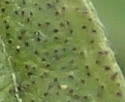Psoralidium tenuiflorum (Slenderleaf Scurfpea)
| Also known as: | Wild Alfalfa, Scurfy Pea |
|---|---|
| Genus: | Psoralidium |
| Family: | Fabaceae (Pea) |
| Life cycle: | perennial |
| Origin: | native |
| Status: |
|
| Habitat: | sun; dry sandy or rocky soil; bluff prairie |
| Bloom season: | May - June |
| Plant height: | 1 to 3 feet |
| Wetland Indicator Status: | none |
| MN county distribution (click map to enlarge): |  |
| National distribution (click map to enlarge): |  |
Pick an image for a larger view. See the glossary for icon descriptions.
Detailed Information
Flower: 

![[photo of flowers]](/udata/r9ndp23q/pd/psoralidium-tenuiflorum-84369-42-t.jpg) Loose racemes with 1 to 4 flowers clustered along the tips of branching stems. Flowers are about ¼ inch long, light blue to purple to deep blue-violet, pea-shaped with a broad, rounded upper petal (standard) and 2 broad lateral petals. The calyx surrounding the base is tubular, green to dark purple, variously covered in white hairs, and gland-dotted. Flower stalks are ¼ to 1/3 inch long, green to dark purple, and covered in white hairs.
Loose racemes with 1 to 4 flowers clustered along the tips of branching stems. Flowers are about ¼ inch long, light blue to purple to deep blue-violet, pea-shaped with a broad, rounded upper petal (standard) and 2 broad lateral petals. The calyx surrounding the base is tubular, green to dark purple, variously covered in white hairs, and gland-dotted. Flower stalks are ¼ to 1/3 inch long, green to dark purple, and covered in white hairs.
Leaves and stems: 


![[photo of hairy leaf underside]](/udata/r9ndp23q/pd/psoralidium-tenuiflorum-84369-29-t.jpg) Leaves are alternate, palmately compound, typically with 5 leaflets on the main stem and 3 leaflets on branches. Leaflets are ½ to 2 inches long, up to ½ inch wide, narrowly elliptic, widest at or above the middle, toothless, and short stalked. The upper surface is gland-dotted (most easily seen on dry leaves) and nearly hairless, the lower surface is densely covered in appressed white hairs. The compound leaf stalk is up to 3/8 inch long and variously hairy.
Leaves are alternate, palmately compound, typically with 5 leaflets on the main stem and 3 leaflets on branches. Leaflets are ½ to 2 inches long, up to ½ inch wide, narrowly elliptic, widest at or above the middle, toothless, and short stalked. The upper surface is gland-dotted (most easily seen on dry leaves) and nearly hairless, the lower surface is densely covered in appressed white hairs. The compound leaf stalk is up to 3/8 inch long and variously hairy.
![[photo of stipules and hairy stem]](/udata/r9ndp23q/pd/psoralidium-tenuiflorum-84369-33-t.jpg) At the base of the leaf stalk is a pair of leafy appendages (stipules) that are hairy and linear to narrowly triangular. Stems are erect to ascending, single or multiple from the base, many branched, faintly ridged, and variously covered in white hairs.
At the base of the leaf stalk is a pair of leafy appendages (stipules) that are hairy and linear to narrowly triangular. Stems are erect to ascending, single or multiple from the base, many branched, faintly ridged, and variously covered in white hairs.
Fruit: 
![[photo of fruit]](/udata/r9ndp23q/pd/psoralidium-tenuiflorum-84369-21-t.jpg) Fruit is a slightly flattened pod ¼ to 1/3 inch long, oval with an abrupt taper to a short beak at the tip, and densely gland-dotted.
Fruit is a slightly flattened pod ¼ to 1/3 inch long, oval with an abrupt taper to a short beak at the tip, and densely gland-dotted.
Notes:
Slenderleaf Scurfpea, known in some refereneces as Pediomelum tenuiflorum, is a species of sandy and rocky prairies as well as mountainous regions and is more common to our south and west, with the Minnesota populations somewhat disjunct from the rest. According to the DNR, it was only known from 2 locations in the state, the records dating back to 1890 and 1915, and was not seen again until the 1990s when it was rediscovered at one of the original sites and 2 others nearby. Populations are small, however, and it was listed as an Endangered species in 1996 due to its extreme rarity. It is most easily recognized by the gland-dotted leaves, calyx and fruit, overall hairiness, and leaves palmately compound in 3s or 5s. Somewhat similar is Silverleaf Scurfpea (Pediomelum argophyllum), which has silvery foliage and stems from the dense covering of silvery hairs, broader leaflets in 3s, 4s or 5s, has stalkless, deep blue-violet flowers, and is not gland-dotted. Slenderleaf Scurfpea is also sometimes called Wild Alfalfa and is somewhat similar to the agricultural escapee Alfalfa (Medicago sativa), which has blue-green leaves that are sparsely hairy and always in 3s, and pods that are coiling and not gland-dotted.
Native Plant Nurseries, Restoration and Landscaping Services ↓
More photos
 Slenderleaf Scurfpea plant
Slenderleaf Scurfpea plant Slenderleaf Scurfpea plant
Slenderleaf Scurfpea plant Slenderleaf Scurfpea plant
Slenderleaf Scurfpea plant Slenderleaf Scurfpea habitat
Slenderleaf Scurfpea habitat lower leaf with 5 leaflets
lower leaf with 5 leaflets glands are easily seen on drying leaves
glands are easily seen on drying leaves more flowers and buds
more flowers and buds
Photos courtesy Peter M. Dziuk taken in Fillmore County.
Comments
Have you seen this plant in Minnesota, or have any other comments about it?






